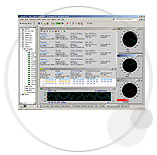 BES Electronic
Systyems
BES Electronic
Systyems
Home
Products & Services
Contact us
CMC-e- 600 ICD
CMC-e-600
Built for the CAAS system on the CH-47F, MH-47G and MH-60L/M , the dataMARS CMC-e-600 is an exceptional solution for flight-data recording and analysis, completely integrating an airborne recording unit with powerful ground analysis software. The CMC-e-600 made from the Flight Worthy CMC-e rugged PC with the dataMARS software. The recorder includes a Removable Memory Module (RMM) of 0.5 Terabyte that stores the collected flight data. During flight the unit monitors and records the entire traffic, (or selected portions) of two MIL-STD-1553 buses and the entire traffic (NDO level) of two Ethernet channels. Before and during the flight the unit is capable to display monitored engineering-unit data, enabling quick and informed decision-making during and between flights. Recorded data is time tagged with reference to IRIG-B time code or internal PC clock. Once on the ground, the RMM pocket-sized, media cartridge can be easily removed and taken to the lab, where the powerful Windows-based dataMARS post-analysis software immediately accesses and analyzes the data, with no downloading required. The dataMARS post-analysis software provides advanced data presentation, manipulation, interrogation, reporting and exporting capabilities. Reliable and rugged, the The CMC-e-600 is SOF (Safety of Flight) tested, flight qualified and can withstand severe environmental conditions. Compact and easy to install, the unit is self-cooled and operates autonomously from a 12-36VDC power source. |
|||||||||||||||
|
dataMars on CMC-e-600 Platform
|
|
||||||||||||||
|
Recording Media:
Data Sources
Power
|
Dimensions & Weight 230x245x370 [mm] (WxHxL) with base and mounts Weight approx.12Kg with mount and shock isolators
Environmental
Operating Temperature: 0°C - 55°C Non-operating Temperature: -20°C - 85°C Relative humidity: Up to 95% relative humidity, non-condensing, MIL-STD-810F Salt Fog: 5% solution per MIL-STD-810F method 509.3 Vibrations: MIL-STD-810F Shock: MIL-STD-810F for flight equipment 15g, 11ms saw tooth Altitude: 15,500ft (or the equivalent atmospheric pressure) operating and non-operating with hard disk, 15,00ft 40.000ft non- operating EMI/RFI: MIL-STD-461C Categories CE03, RE02, RS03, CS02 Fungus: MIL-STD-810F Sand and Dust: per MIL-STD-810F |
||||||||||||||
|
|
|||||||||||||||||||||
|
|
Message Structure Database
|
||||||||||||||||||||
|
|
|||||||||||||||||||||
|
|
Data Display
Virtual Panels
Virtual Panels are useful in mimicking the look, feel and operation of real equipment used by the pilot by presenting the recorded data via "real-life" controls. The intuitive interface is especially helpful for users who are not familiar with the dataMARS and dataSIMS systems. Post-analysis Capabilities
Post-analysis is performed on engineering-unit values decoded from the recorded data, which are displayed using a variety of presentation formats, and reported in flexible reporting formats. Specific events and conditions can be searched for in the recorded data, and calculations may be performed on it to extract new information to be displayed and reported alongside the recorded data. Recorded data may be exported to other third-party tools, such as Excel™ and MatLab™. Data from multiple sources are replayed synchronously, based on recorded time tags. The data may be replayed at various rates, such as 1:1 and full speed. Aside from the engineering displays that show recorded
Data Reporting and Exporting
Use other optional conversion tools to convert recorded data to various third party binary formats. Reported data may be used in Excel™, MatLab™ and other tools for dedicated analysis and presentation. Reports may also be distributed to other interested parties
Custom Data
Custom data are monitored and simulated alongside standard protocols (for example, MIL-STD-1553 or ARINC-429), which re-emphasizes the complete and system-wide approach taken by the dataMARS and dataSIMS
ARINC-429
Ethernet
Copyright © 2010. BES Systems Ltd. 14 Moshe Levi St. Rishon Unit 30 Israel, CAGE SK477 Tel: +972-3-5714998 Fax:+972-3-571-5085 email: asherlav@bes.co.il
|










